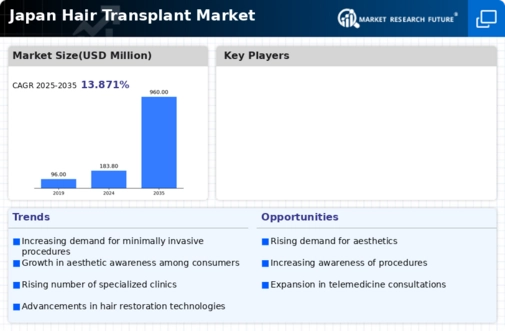Aging Population and Demand for Restoration
Japan's aging population is a crucial factor influencing the hair transplant market. As the demographic shifts towards an older age group, the prevalence of hair loss issues increases, prompting a greater demand for restoration solutions. Reports indicate that nearly 40% of men and 25% of women over the age of 50 experience noticeable hair thinning. This demographic trend is compelling many individuals to seek hair transplant procedures as a viable option to regain their youthful appearance. The hair transplant market is adapting to this demographic shift by offering tailored solutions that cater specifically to older adults. Clinics are increasingly focusing on providing age-appropriate consultations and procedures, which may enhance patient satisfaction and outcomes. Consequently, the market is likely to see sustained growth as more elderly individuals prioritize their appearance and seek effective hair restoration treatments.
Increasing Awareness of Hair Loss Solutions
The rising awareness regarding hair loss solutions is a pivotal driver in the hair transplant market. In Japan, a growing number of individuals are becoming cognizant of the psychological and social impacts of hair loss. This awareness is leading to increased inquiries and consultations for hair transplant procedures. According to recent surveys, approximately 30% of the population expresses concern about hair thinning, which has resulted in a surge in demand for effective solutions. The hair transplant market is witnessing a shift as more clinics offer educational resources and consultations, thereby enhancing public knowledge. This trend is likely to continue, as media campaigns and social media influencers promote hair restoration options, further driving the market's growth. As a result, the industry is expected to expand significantly, catering to a more informed consumer base seeking reliable hair restoration methods.
Cultural Shifts Towards Aesthetic Enhancement
Cultural shifts in Japan are increasingly favoring aesthetic enhancement, which significantly impacts the hair transplant market. The societal perception of beauty is evolving, with more individuals viewing hair restoration as a means to improve self-esteem and confidence. This cultural change is reflected in the rising number of consultations and procedures performed annually. Recent data suggests that the hair transplant market has experienced a growth rate of approximately 15% over the past few years, driven by this shift in mindset. As beauty standards continue to evolve, more people are likely to consider hair transplants as a legitimate option for enhancing their appearance. This trend may lead to a broader acceptance of hair restoration procedures, further propelling the market's growth in the coming years.
Technological Innovations in Hair Restoration
Technological innovations are transforming the hair transplant market, making procedures more efficient and effective. In Japan, advancements such as robotic-assisted hair transplants and improved grafting techniques are gaining traction. These innovations not only enhance the precision of hair restoration but also reduce recovery times for patients. For instance, the introduction of Follicular Unit Extraction (FUE) has revolutionized the way hair transplants are performed, allowing for minimally invasive procedures with less scarring. The hair transplant market is witnessing a surge in clinics adopting these advanced technologies, which may lead to increased patient trust and satisfaction. As technology continues to evolve, it is anticipated that the market will expand further, with more individuals opting for these state-of-the-art solutions to address their hair loss concerns.
Increased Accessibility of Hair Transplant Services
The increased accessibility of hair transplant services is a notable driver in the hair transplant market. In Japan, the proliferation of specialized clinics and the availability of financing options have made hair restoration procedures more attainable for a wider audience. Many clinics now offer flexible payment plans, which can alleviate the financial burden associated with these procedures. This trend is particularly relevant as the average cost of hair transplants can range from ¥300,000 to ¥600,000, depending on the technique and clinic. The hair transplant market is responding to this demand by expanding service offerings and improving patient experiences. As accessibility continues to improve, it is likely that more individuals will consider hair transplants as a feasible solution for their hair loss issues, thereby driving market growth.











Leave a Comment